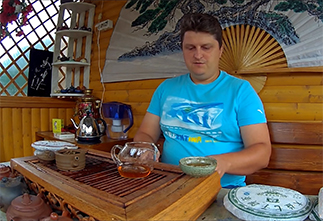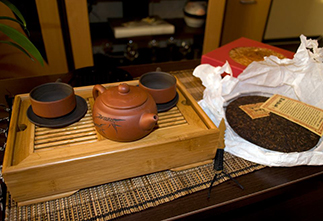-
0 Saturation
-
0 Aftertaste
-
0 Aroma
-
0 Effect
-
0 Balance
-
0 Body
Шу Пуэр 2016 г. "Старая мелодия уезда Мэнхай" марки "Кайшуньхао": Классика жанра
Старая мелодия уезда Мэнхай (кит. 勐海陈韵熟茶, пиньинь Měng hǎi chén yùn shú chá) – это не просто название чая, это поэтическое описание его глубокого, насыщенного вкуса и аромата, сотканного из многовековых традиций производства пуэра. Шу пуэр 2016 года от марки "Кайшуньхао" – это шедевр чайного искусства, который с каждым годом становится только лучше.
Что особенного в этом чае?
- Происхождение: Чайные листья для этого пуэра собраны в уезде Мэнхай, сердце чайной провинции Юньнань. Именно здесь растут лучшие чайные деревья, дающие сырье для создания поистине выдающихся пуэров.
- Обработка: Чай проходит традиционную обработку для шу пуэра, включающую искусственное ускорение процесса ферментации. Это придает чаю мягкий, округлый вкус и насыщенный темно-коричневый цвет.
- Вкус: "Старая мелодия уезда Мэнхай" – это чай с богатым, сложным вкусом. В нем гармонично сочетаются нотки сухофруктов, орехов, древесины и земли. Послевкусие долгое, с приятной сладостью.
- Аромат: Аромат чая насыщенный, с преобладанием древесных и землистых нот. С каждым новым проливом он раскрывается все ярче и сложнее.
- Эффект: Шу пуэр обладает согревающим эффектом, улучшает пищеварение, укрепляет иммунитет и способствует расслаблению.
Почему стоит попробовать этот чай?
- Классический вкус: "Старая мелодия уезда Мэнхай" – это эталон классического шу пуэра.
- Высокое качество: Марка "Кайшуньхао" известна своим высоким качеством продукции.
- Полезные свойства: Шу пуэр – это не только вкусный, но и полезный напиток.
- Инвестиции в будущее: Шу пуэр со временем становится только лучше, поэтому его можно рассматривать как долгосрочные инвестиции.
Как заваривать?
Для того чтобы раскрыть весь потенциал этого чая, рекомендуется использовать гайвань или чахай. Температура воды для заваривания должна быть около 95°C. Время заваривания зависит от ваших предпочтений, но обычно составляет от 5 до 10 секунд для первой проливки и увеличивается с каждой последующей.
Шу пуэр 2016 г. "Старая мелодия уезда Мэнхай" марки "Кайшуньхао" – это настоящий подарок для ценителей китайского чая. Этот чай подарит вам незабываемые вкусовые ощущения и станет прекрасным дополнением к вашей чайной коллекции.
|
Name in Chinese
|
勐海陈韵熟茶 |
|
Pinyin
|
Měng hǎi chén yùn shú chá |
|
Translation
|
Shu Pu'er Old Melody of Menghai County |
|
Country
|
China |
|
Provinces
|
Yunnan (云南) |
|
Manufacturer
|
Кайшуньхао (开顺号) |
|
Raw material production date
|
28.03.2016 |
|
Year of pressing
|
2016 |
|
Pressing form
|
Bing Cha (Cake Tea) |
- Reviews
- Vkontakte
The question often arises: how to brew puerh correctly? Sometimes the phrase "to get high" is added to it. Moreover, everyone has their own understanding of this phrase. Some mean vigor, and some - intoxication. So how to brew puerh tea correctly? Let's consider several options.
Traveling through the tea mountains, we found ourselves in another land of blue roofs - the village of Zhongcai, which is located in the Menghai district of Yunnan province. According to tradition, we were shown another local tea tree, which, according to the Chinese, is at least a million years old :) The village is very authentic, not designed for tourists, there are many wild pu-erhs there and, of course, we were warmly received. They treated us to local cuisine and tea. We also asked the residents about the prices of tea and how they have changed in recent years.
The tea ceremony occupies a special place in the centuries-old Eastern tradition. And although the essence of this phenomenon remains constant, the nature and external manifestations of the tea ceremony in different nations have their own national characteristics. In each Chinese province, the tea ceremony and the tea used in it are varied: for example, residents of the southern provinces prefer green tea, and residents of the northern provinces - red tea, in Fujian province they more often use Oolong tea, and in Yunnan province Puer tea is widely known.



























































































